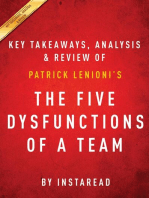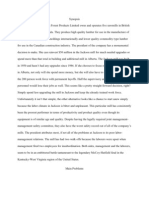Introduction
Introduction
Uploaded by
Angelo A. GuevaraCopyright:
Available Formats
Introduction
Introduction
Uploaded by
Angelo A. GuevaraCopyright
Available Formats
Share this document
Did you find this document useful?
Is this content inappropriate?
Copyright:
Available Formats
Introduction
Introduction
Uploaded by
Angelo A. GuevaraCopyright:
Available Formats
The Ideal Team Player: How to Recognize and Cultivate the Three
Essential Virtues: A Leadership Fable
by Patrick Lencioni
John Wiley & Sons (US). (c) 2016. Copying Prohibited.
Reprinted for Angelo Guevara, Lockheed Martin Corporation
angelo.a.guevara@lmco.com
Reprinted with permission as a subscription benefit of Skillport,
http://skillport.books24x7.com/
All rights reserved. Reproduction and/or distribution in whole or in part in electronic,paper or
other forms without written permission is prohibited.
The Ideal Team Player: How to Recognize and Cultivate the Three Essential Virtues: A Leadership Fable
Introduction
If someone were to ask me to make a list of the most valuable qualities a person should develop in order to thrive in the world of work—and for
that matter, life—I would put being a team player at the top. The ability to work effectively with others, to add value within the dynamics of a
group en-deavor, is more critical in today’s fluid world than it has ever been. Few people succeed at work, in the family, or in any social context
without it.
I’m sure that most people would agree with this, which is why it’s a little surprising that great team players are somewhat rare. I think the
problem is that we’ve failed to define what being a team player requires, which leaves the concept somewhat vague, even soft.
It’s not unlike teamwork itself, which still gets more lip service than practical attention. In my book, The Five Dysfunctions of a Team, I
explained that real teamwork requires tangible, specific behaviors: vulnerability-based trust, healthy conflict, active commitment, peer-to-peer
accountability, and a focus on results. Thankfully, with enough coaching, patience, and time, most people can learn to embrace those
concepts.
However, I must admit that some people are better at being team players, at embracing those five behaviors, than others. They’re not born that
way, but either through life experiences, work history, or a real commitment to personal development, they come to possess the three
underlying virtues that enable them to be ideal team players: they are humble, hungry, and smart. As simple as those words may appear, none
of them is exactly what they seem. Understanding the nuances of these virtues is critical for applying them effectively.
During the past twenty years of working with leaders and their teams, I’ve seen time and again that when a team member lacks one or more of
these three virtues, the process of building a cohesive team is much more difficult than it should be, and in some cases, impossible. We’ve
been using this approach for hiring and management at The Table Group since our founding in 1997, and it has proven to be a remarkable
predictor of success, as well as a reliable explanation of failure. As a result, we’ve come to the conclusion that these three seemingly obvious
qualities are to teamwork what speed, strength, and coordination are to athletics—they make everything else easier.
The ramifications of all this are undeniable. Leaders who can identify, hire, and cultivate employees who are humble, hungry, and smart will
have a serious advantage over those who cannot. They’ll be able to build stronger teams much more quickly and with much less difficulty, and
they’ll significantly reduce the painful and tangible costs associated with politics, turnover, and morale problems. And employees who can
embody these virtues will make themselves more valuable and marketable to any organization that values teamwork.
The purpose of this little book is to help you understand how the elusive combination of these three simple attributes can accelerate the
process of making teamwork a reality in your organization or in your life so you can more effectively achieve the extraordinary benefits that it
brings.
I hope it serves you well.
Page 2 / 2
Reprinted for QO4WH/134413, Lockheed Martin Corporation John Wiley & Sons (US), Patrick Lencioni (c) 2016, Copying Prohibited
You might also like
- The Ideal Team Player: How to Recognize and Cultivate The Three Essential VirtuesFrom EverandThe Ideal Team Player: How to Recognize and Cultivate The Three Essential VirtuesRating: 4 out of 5 stars4/5 (38)
- Ethics Summative 2 & 3Document4 pagesEthics Summative 2 & 3Von Andrei Medina100% (3)
- The Model 1 The Three Virtues of An Ideal Team PlayerDocument2 pagesThe Model 1 The Three Virtues of An Ideal Team PlayerAngelo A. GuevaraNo ratings yet
- The Model - 4 - The-Ideal-Team-Player-ModelDocument4 pagesThe Model - 4 - The-Ideal-Team-Player-ModelAngelo A. GuevaraNo ratings yet
- The Five Dysfunctions of a Team: A Leadership Fable, 20th Anniversary EditionFrom EverandThe Five Dysfunctions of a Team: A Leadership Fable, 20th Anniversary EditionRating: 4 out of 5 stars4/5 (40)
- The Five Dysfunctions of a Team: A Leadership Fable" by Patrick LencioniFrom EverandThe Five Dysfunctions of a Team: A Leadership Fable" by Patrick LencioniRating: 3.5 out of 5 stars3.5/5 (2)
- Summary of The Five Dysfunctions of a Team: by Patrick Lencioni | Includes AnalysisFrom EverandSummary of The Five Dysfunctions of a Team: by Patrick Lencioni | Includes AnalysisRating: 4.5 out of 5 stars4.5/5 (7)
- The Great CEO WithinDocument134 pagesThe Great CEO WithinMani Sood100% (6)
- Organizational Behavior Case 1Document7 pagesOrganizational Behavior Case 1tjones51002100% (2)
- Book Summary Chapter 1: Good Is The Enemy of GreatDocument8 pagesBook Summary Chapter 1: Good Is The Enemy of Greatajq007100% (6)
- Why Teams Don T Work HackmanDocument13 pagesWhy Teams Don T Work Hackmananon_612979508No ratings yet
- Teamwork Is an Individual Skill: Getting Your Work Done When Sharing ResponsibilityFrom EverandTeamwork Is an Individual Skill: Getting Your Work Done When Sharing ResponsibilityRating: 4 out of 5 stars4/5 (4)
- Nobodys Perfect But A Team Can BeDocument8 pagesNobodys Perfect But A Team Can BeVedranGranc100% (1)
- Buad 821 Business Ethics and Corporate GovernanceDocument16 pagesBuad 821 Business Ethics and Corporate GovernanceYemi Jonathan OlusholaNo ratings yet
- Positive and Negative Filipinos ValuesDocument5 pagesPositive and Negative Filipinos Valuesmarivic marcelo95% (21)
- Howard Roark's Courtroom SpeechDocument9 pagesHoward Roark's Courtroom SpeechmartaNo ratings yet
- The Model - 7 - Connecting-the-Ideal-Team-Player-Model-with-the-Five-Dysfunctions-of-a-TeamDocument2 pagesThe Model - 7 - Connecting-the-Ideal-Team-Player-Model-with-the-Five-Dysfunctions-of-a-TeamAngelo A. GuevaraNo ratings yet
- The Model 3 The History of The ModelDocument2 pagesThe Model 3 The History of The ModelAngelo A. GuevaraNo ratings yet
- The Model 2 Defining The Three VirtuesDocument3 pagesThe Model 2 Defining The Three VirtuesAngelo A. GuevaraNo ratings yet
- Summary of The Ideal Team Player by Patrick M. Lencioni: How to Recognize and Cultivate the Three Essential Virtues: A Leadership FableFrom EverandSummary of The Ideal Team Player by Patrick M. Lencioni: How to Recognize and Cultivate the Three Essential Virtues: A Leadership FableNo ratings yet
- Are We A Team Case AnalysisDocument6 pagesAre We A Team Case AnalysisAlexandra Gatchallan100% (2)
- Are We A TeamDocument6 pagesAre We A TeamAlexandra GatchallanNo ratings yet
- 5 Dysfunction SummaryDocument5 pages5 Dysfunction Summarybushra asad khanNo ratings yet
- Team Building Assement FormDocument8 pagesTeam Building Assement FormHiermela HagosNo ratings yet
- ArticleDocument2 pagesArticleGourav PandiyaNo ratings yet
- The 3 Keys to Empowerment: Release the Power Within People for Astonishing ResultsFrom EverandThe 3 Keys to Empowerment: Release the Power Within People for Astonishing ResultsNo ratings yet
- Patrick M. Lencioni - The Five Dysfunctions of a TeamDocument11 pagesPatrick M. Lencioni - The Five Dysfunctions of a TeamPradeep NagarajNo ratings yet
- What Makes A Group of People A TeamDocument6 pagesWhat Makes A Group of People A TeamNikhil MunjalNo ratings yet
- Gino Tebr Apr2013Document3 pagesGino Tebr Apr2013hc++No ratings yet
- Name Atif Butt Reg No. 1179-FMS/MS/S20 Faculty of Management Sciences International Islamic University IslamabadDocument12 pagesName Atif Butt Reg No. 1179-FMS/MS/S20 Faculty of Management Sciences International Islamic University IslamabadAtif Butt 1179-FMS/MS/S20No ratings yet
- Team BuildingDocument22 pagesTeam BuildingAmbuj ChaturvediNo ratings yet
- High-Performing Teams: A Timeless Leadership TopicDocument5 pagesHigh-Performing Teams: A Timeless Leadership Topicgooyaaa13No ratings yet
- Kalinga Keshari Samal 10RDM-19 "Teamwork Is More Advocated Than Being Practiced in Organizations"Document13 pagesKalinga Keshari Samal 10RDM-19 "Teamwork Is More Advocated Than Being Practiced in Organizations"KALINGANo ratings yet
- TeamworkDocument11 pagesTeamworkSR-71 BLACKBIRDNo ratings yet
- Team Management PlaybookDocument211 pagesTeam Management PlaybookErick H. Gaytán100% (9)
- Chapter 10 Using Teams in OrganizationDocument26 pagesChapter 10 Using Teams in OrganizationNeexhianna ACENo ratings yet
- Employee Motivation: A Powerful New Model: by Nitin Nohria, Boris Groysberg, and Linda-Eling LeeDocument6 pagesEmployee Motivation: A Powerful New Model: by Nitin Nohria, Boris Groysberg, and Linda-Eling LeeDavid SaldivarNo ratings yet
- WarrickDocument8 pagesWarrickLuirNo ratings yet
- Transcription - M2S2Document19 pagesTranscription - M2S2GrowUP. AINo ratings yet
- Turning Individ-WPS OfficeDocument7 pagesTurning Individ-WPS OfficeJomalyn HabibonNo ratings yet
- Executives Need A Path To Enhancing Their Strengths That Is As Clear As The One To Fixing Their WeaknessesDocument1 pageExecutives Need A Path To Enhancing Their Strengths That Is As Clear As The One To Fixing Their WeaknessesMyDoc09No ratings yet
- Summary of The Ideal Team Player: by Patrick Lencioni | Includes AnalysisFrom EverandSummary of The Ideal Team Player: by Patrick Lencioni | Includes AnalysisNo ratings yet
- The Power of A TeamDocument4 pagesThe Power of A TeamSaba AsimNo ratings yet
- Robles Castaneda Noe The Five Dysfunctions of A Team Book ReviewDocument5 pagesRobles Castaneda Noe The Five Dysfunctions of A Team Book Reviewapi-547598563No ratings yet
- Harvard Business ReviewDocument10 pagesHarvard Business ReviewVihangaPerisNo ratings yet
- Team Composition Selecting Right Team MembersDocument2 pagesTeam Composition Selecting Right Team MembersDharmendra GuptaNo ratings yet
- Creating An Execution CultureDocument4 pagesCreating An Execution CulturesprathNo ratings yet
- The Wisdom of TeamsDocument2 pagesThe Wisdom of Teamssptn5hxkx5No ratings yet
- Business Communication H05BTN-PDF-ENGDocument10 pagesBusiness Communication H05BTN-PDF-ENGManu LNo ratings yet
- The Chief HR Officer: Defining the New Role of Human Resource LeadersFrom EverandThe Chief HR Officer: Defining the New Role of Human Resource LeadersNo ratings yet
- Beyond Engagement: A Guide to Building Healthy and Successful OrganizationsFrom EverandBeyond Engagement: A Guide to Building Healthy and Successful OrganizationsNo ratings yet
- Smooth Scaling: Twenty Rituals to Build a Friction-Free OrganizationFrom EverandSmooth Scaling: Twenty Rituals to Build a Friction-Free OrganizationNo ratings yet
- Hackman (2011) Teamwork MisperceptionsDocument4 pagesHackman (2011) Teamwork MisperceptionsMartin FuentesNo ratings yet
- There's No "I" in Team: Prepared & Compiled By: MattDocument6 pagesThere's No "I" in Team: Prepared & Compiled By: MattMatt MattNo ratings yet
- Developing A Team CharterDocument4 pagesDeveloping A Team CharterJ. ZhouNo ratings yet
- FiveDysfunctions Summary PDFDocument3 pagesFiveDysfunctions Summary PDF7jgk79dcjgNo ratings yet
- Why Don T WorkDocument13 pagesWhy Don T WorkMaria MariaNo ratings yet
- Alignment, Process, Relationships: A Simple Guide to Team ManagementFrom EverandAlignment, Process, Relationships: A Simple Guide to Team ManagementNo ratings yet
- Go Team!: Take Your Team to the Next Level: 3 Steps to Great ResultsFrom EverandGo Team!: Take Your Team to the Next Level: 3 Steps to Great ResultsRating: 4.5 out of 5 stars4.5/5 (2)
- f9 Sexting Activity1&2Document2 pagesf9 Sexting Activity1&2carolinalvesbcNo ratings yet
- CSS Gender Studies Subjective Past Paper 2018Document1 pageCSS Gender Studies Subjective Past Paper 2018mazhar chromeNo ratings yet
- DEPEDBATS CID F 010 Post Observation Supervisor To PrincipalDocument3 pagesDEPEDBATS CID F 010 Post Observation Supervisor To PrincipalNoella Janeel Brotonel100% (2)
- en 20211124Document26 pagesen 20211124chaky212No ratings yet
- Cary Churchill Great Women To Top GirlsDocument25 pagesCary Churchill Great Women To Top GirlsKazuma SatoNo ratings yet
- Affidavit of Undertaking: IN WITNESS WHEREOF, I Have Hereunto Affixed My Signature This 20 Day ofDocument1 pageAffidavit of Undertaking: IN WITNESS WHEREOF, I Have Hereunto Affixed My Signature This 20 Day ofCenteno Santos JasonNo ratings yet
- Chapter-7 Science TechnologyDocument8 pagesChapter-7 Science TechnologyJunlip SalarNo ratings yet
- DEVELOS Self-ConceptDocument3 pagesDEVELOS Self-ConceptArchie DevelosNo ratings yet
- Williams Obstetrics 25th Edition All Chapters Instant DownloadDocument24 pagesWilliams Obstetrics 25th Edition All Chapters Instant Downloadhafdivivere100% (3)
- SH Bus - Ethics q3 Week 2 LC 1.4 and 1.5Document16 pagesSH Bus - Ethics q3 Week 2 LC 1.4 and 1.5karenmgeneblazoNo ratings yet
- Heroism Thesis StatementDocument6 pagesHeroism Thesis StatementPaperWritingHelpOnlineReno100% (2)
- A) Natural Law With Indian Perspective - 20240921 - 112940 - 0000Document24 pagesA) Natural Law With Indian Perspective - 20240921 - 112940 - 0000ambarsinghnawabiNo ratings yet
- Quiz (Fact J Opinion J Assertion - EditedDocument3 pagesQuiz (Fact J Opinion J Assertion - EditedCrystalle Mae Genson100% (1)
- Business Law Test Banks Chapter 1Document16 pagesBusiness Law Test Banks Chapter 1John WillisNo ratings yet
- 伽达摩尔GadamerDocument15 pages伽达摩尔GadamerlamarckcanadaNo ratings yet
- Narir Niti: (Woman'S Code)Document61 pagesNarir Niti: (Woman'S Code)Husnie Al-mubarok AfandieNo ratings yet
- Lecture 4 Ethics&CSRDocument40 pagesLecture 4 Ethics&CSRngan nguyenNo ratings yet
- Blockchain, Fintech, and Islamic Finance. Building The Future in The New Islamic Digital Economy Hazik MohamedDocument62 pagesBlockchain, Fintech, and Islamic Finance. Building The Future in The New Islamic Digital Economy Hazik Mohamedbunietelnes65100% (3)
- They Say I Say TemplatesDocument8 pagesThey Say I Say Templates陈曦No ratings yet
- Mumu WorkDocument3 pagesMumu Workyusuf nasiruNo ratings yet
- Anna Karenina - Literary CriticismDocument2 pagesAnna Karenina - Literary Criticismkiratuz199850% (2)
- LJU4802.Sem 1 2023.case For Ass 01 - NaickerDocument15 pagesLJU4802.Sem 1 2023.case For Ass 01 - NaickerHD Movies and seriesNo ratings yet
- ارتفاقات التعمير كقيد على حق البناء Reconstruction easements as a restriction to the right to build PDFDocument25 pagesارتفاقات التعمير كقيد على حق البناء Reconstruction easements as a restriction to the right to build PDFHab BaNo ratings yet
- Week 3 Q3 Business EthicsDocument7 pagesWeek 3 Q3 Business EthicsCristine SilvaNo ratings yet
- NMCC 2024 PropositionDocument5 pagesNMCC 2024 Proposition28-JessicaNo ratings yet
- Jonathan A. Tabilin 2019Document36 pagesJonathan A. Tabilin 2019Marvin TabilinNo ratings yet

























































































